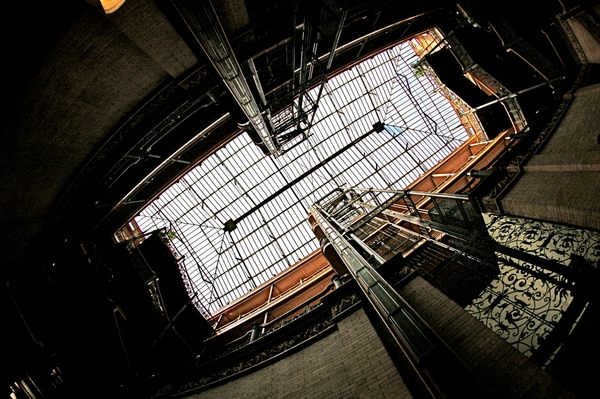Aqsa Mosque in Qadian, India
While the Golden Temple in Amritsar is a world-famous symbol of Indian Punjab, Sikhism is not the only religion that was founded in the state. In the late 19th century, the Ahmadiyya sect of Islam was founded in the small town of Qadian. The Aqsa Mosque was built at what was then the home of Ahmadiyya's founder, Mirza Ghulam Ahmad. He claimed to be the second coming of Jesus Christ as well as the Mahdi, who, in Islam, is to deliver justice during the end times. Ahmad stated the goals of his movement to be peaceful moral reformation and the global revival of Islam. Through his numerous publications and public debates with those of other religions, Ahmadiyya spread across British India. It had 400,000 followers by the time of Ahmad's death in 1908. To back up his claim of being the Messiah, Ahmad cited a hadith (anecdote of the prophet Muhammad) stating that Jesus would return at a white minaret east of Damascus. He also claimed that Muhammad acended to heaven from Qadian, rather than the Al-Aqsa in Jerusalem. Although Ahmad interpreted the white minaret as merely symbolic, he committed to building a real one representing the pre-eminence of Islam. The White Minaret was completed after his death in 1916, and is now on the Ahmadiyya flag as a symbol of the movement. After the partition of India in 1947, the Ahmadiyya moved their headquarters to Pakistan. (Due to continued religious discrimination, they relocated again to the UK in 1984.) However, several hundred members known as the darveshān-i Qādiyān (dervishes of Qadian) were ordered to remain to oversee the Aqsa mosque. Today, it has been greatly expanded to a capacity of 15,000, compared to just 200 when it was originally founded by Ghulam Ahmad's father, Mirza Ghulam Murtaza.


While the Golden Temple in Amritsar is a world-famous symbol of Indian Punjab, Sikhism is not the only religion that was founded in the state. In the late 19th century, the Ahmadiyya sect of Islam was founded in the small town of Qadian.
The Aqsa Mosque was built at what was then the home of Ahmadiyya's founder, Mirza Ghulam Ahmad. He claimed to be the second coming of Jesus Christ as well as the Mahdi, who, in Islam, is to deliver justice during the end times. Ahmad stated the goals of his movement to be peaceful moral reformation and the global revival of Islam. Through his numerous publications and public debates with those of other religions, Ahmadiyya spread across British India. It had 400,000 followers by the time of Ahmad's death in 1908.
To back up his claim of being the Messiah, Ahmad cited a hadith (anecdote of the prophet Muhammad) stating that Jesus would return at a white minaret east of Damascus. He also claimed that Muhammad acended to heaven from Qadian, rather than the Al-Aqsa in Jerusalem. Although Ahmad interpreted the white minaret as merely symbolic, he committed to building a real one representing the pre-eminence of Islam. The White Minaret was completed after his death in 1916, and is now on the Ahmadiyya flag as a symbol of the movement.
After the partition of India in 1947, the Ahmadiyya moved their headquarters to Pakistan. (Due to continued religious discrimination, they relocated again to the UK in 1984.) However, several hundred members known as the darveshān-i Qādiyān (dervishes of Qadian) were ordered to remain to oversee the Aqsa mosque. Today, it has been greatly expanded to a capacity of 15,000, compared to just 200 when it was originally founded by Ghulam Ahmad's father, Mirza Ghulam Murtaza.





























































![ultimate: "I was overthinking too much, this caused my individual performance [to drop]"](https://img-cdn.hltv.org/gallerypicture/-UadcoXXvAHL1u2sXxdPmD.jpg?auto=compress&ixlib=java-2.1.0&m=/m.png&mw=107&mx=20&my=473&q=75&w=800&s=ecaf0a90caf83f25c2f28eb7894553b3#)






















































































































.jpg)





































































